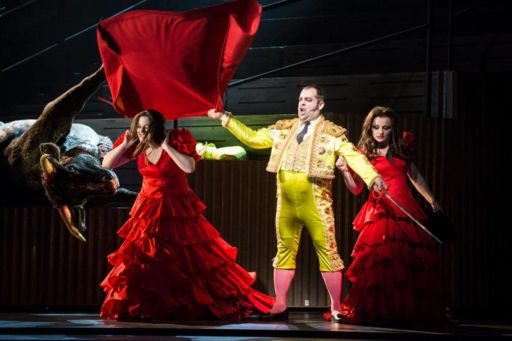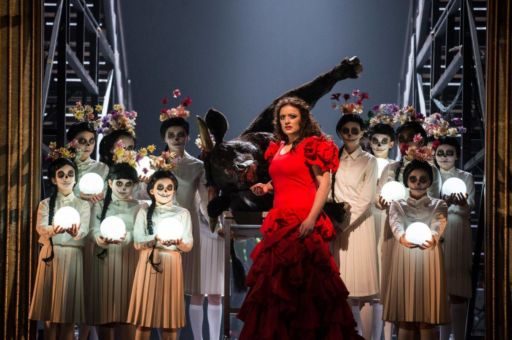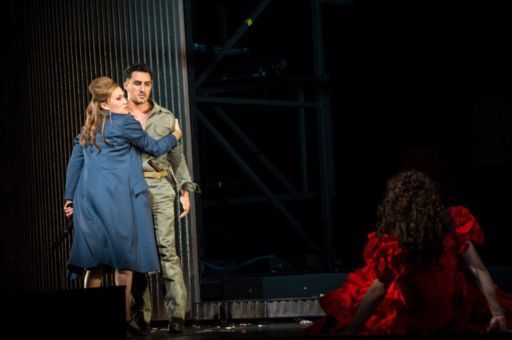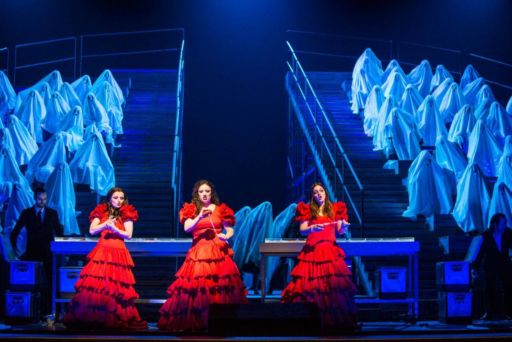Deutsche Oper Berlin, season 2017/2018
“CARMEN”
Opéra Comique in three acts. Libretto by Henri Meilhac and Ludovic Halévy, after the novella by Prosper Mérimée.
Music by Geoges Bizet
Carmen CLÉMENTINE MARGAINE
Frasquita NICOLE HASLETT
Mercédès JANA KURUCOVÁ
Micaëla HEIDI STOBER
Don José CHARLES CASTRONOVO
Escamillo MARKUS BRÜCK
Moralès PHILIPP JEKAL
Zuniga TOBIAS KEHRER
Moralès PHILIPP JEKAL
Remendado YA-CHUNG HUANG
Dancairo DEAN MURPHY
Chor & Orchester der Deutschen Oper Berlin
Kinderchor der Deutschen Oper Berlin
Conductor Ivan Repusic
Chorus Jeremy Bines
Children’s chorus Christian Lindhorst
Choreography Silke Sense
Production Ole Anders Tandberg
Stage Erlend Birkeland
Costumes Maria Geber
Light Ellen Ruge
Berlin, 20th January 2018
The French repertoire has become a main focus of the Deutsche Oper Berlin over the last few years. The aspiring cycle of Grand operas by Giacomo Meyerbeer just completed, the biggest of the Berlin opera houses replaces the gloriously traditional production of Georges Bizet’s Carmen by Peter Beauvais from 1979 with a new one by Ole Anders Tandberg. He used to direct theatre plays and started to turn to opera a couple of years ago such as Lady Macbeth of the Mtsensk District by Shostakovich at the Deutsche Oper in 2015 which will be on show again this season. While his rude naturalism and realism may be appropriate for the opera based on Nikolai Leskov’s sociocritical novella, they are largely out of place for Carmen. I admit that it is one of the most popular operas worldwide and full of clichés that a good director should try to avoid but that does not justify to put all Weltschmerz or problems of today’s world from military violence to organ trafficking into a piece that is about no more than a love triangle. Of course we can consider Carmen an early model for an independent modern woman but as a gipsy, is she not also forced to be self-confident and self-reliant in a dog-eat-dog world? The curtain shows a colourful still-life of the skinned head of an animal with a broken eye, lots of meat and fibres in prevailing bloody red. The longer you look at it the more disturbing it seems to be. Red is also the colour of Carmen’s elaborate flamenco dress with frills and flounces designed by Maria Geber whose other costumes appear rather traditional apart from Escamillo’s bright yellow torero suit that is not really flattering for the singer’s physique. Stage designer Erlend Birkeland places a big round arena with stairs on the revolving stage that serves as a kind of grandstand for all acts from the cigarette factory in the first act to the final bullfighting arena. The stage had to be redesigned after some heavy damage by water at Christmas 2017 due to a sprinkler leakage and new motors had to be built in to revolve it, which  can be clearly heard during the opera night and intermissions become longer after the first and third acts to change the setting. An extra change of scene is necessary in the third act to get the ghost chorus in bed sheets from the grandstand to create space for the killed refugees among whom Micaela is looking for José. In Tandsberg’s approach the traditional coffee and tobacco smugglers turn into human and organ traffickers and Frasquita and Mercédès do not deal out cards to tell the fortune but examine human hearts and kidneys before they throw them into cool boxes for transport. When Micaela appears in the first act to ask the soldiers for Don José she is nearly raped by them equipped with penis-like machine-guns and if there is no girl available, the frustrated soldiers do some masturbation exercise at a corrugated metal wall until they drop dead. Even though the Berlin opera-goers are used to this kind of naturalism, emotions start to fly high when Escamillo cuts the testicles off the dead bull at the end of his song to hand them over to Carmen who plays with and drops them in the orchestra pit in the end. In the same way Don José cuts Carmen’s heart out after he has stabbed her to death after all. I wonder if
can be clearly heard during the opera night and intermissions become longer after the first and third acts to change the setting. An extra change of scene is necessary in the third act to get the ghost chorus in bed sheets from the grandstand to create space for the killed refugees among whom Micaela is looking for José. In Tandsberg’s approach the traditional coffee and tobacco smugglers turn into human and organ traffickers and Frasquita and Mercédès do not deal out cards to tell the fortune but examine human hearts and kidneys before they throw them into cool boxes for transport. When Micaela appears in the first act to ask the soldiers for Don José she is nearly raped by them equipped with penis-like machine-guns and if there is no girl available, the frustrated soldiers do some masturbation exercise at a corrugated metal wall until they drop dead. Even though the Berlin opera-goers are used to this kind of naturalism, emotions start to fly high when Escamillo cuts the testicles off the dead bull at the end of his song to hand them over to Carmen who plays with and drops them in the orchestra pit in the end. In the same way Don José cuts Carmen’s heart out after he has stabbed her to death after all. I wonder if  that is bad taste on an admittedly higher level or mere vulgarity. The audience responded accordingly with lots of boos for Tandberg’s team at the end. Whatever a production is like, Bizet’s Carmen can hardly be beaten especially when the musical performance is as excellent as at the Deutsche Oper. Conductor Ivan Repusic starts the introduction as lively as if he and the Orchester der Deutschen Oper Berlin want to get home again as soon as possible but the stage is already revolving with a cigarillo-smoking Carmen who is alone on the big grandstand. The orchestra plays precisely and brilliantly the original version of the opera with spoken but abridged dialogues. I wonder why the first scene of the last act out of all the others was cancelled. Is it because of the longer intermissions to change the scene or did Tandberg not have an idea of making a chorus gradually appear on stage? So the act starts right with the quadrille, which may be considered musical sacrilege. (As a young opera-goer I used to joke that I would claim money back after a performance for all the notes I had not heard.) Chorus master Jeremy Bines prepared the Chor der Deutschen Oper and Christian Lindhorst the Kinderchor der Deutschen Oper Berlin for a musically impeccable performance. The edgy cast is led by Clémentine Margaine as Carmen and Charles Castronovo as Don José. Once a scholar in the company of the opera house, the young French mezzo-soprano has developed a rapid international career due to her plush and resonant voice which makes her excel in French roles such as Carmen, Dalila and more recently Fidès. Castronovo’s tenor reminds me of del Monaco or Vickers rather than Gedda or Simoneau and tackles the part with italianitá to crown it with a splendid top B at the end of La fleur que tu m’avais jetée. Markus Brück is a vocally ideal Escamillo who avoids the vocal pitfalls of his part skilfully. Heidi Stober is a superb Micaela and makes a musical highlight out of Je dis que rien ne m’epouvante. The bass Tobias Kehrer is a luxurious cast as Zuniga while the scholar Nicole Heslett as Frasquita makes you sit up and take notice. Frenetic applause at the end for the singers, choruses and the orchestra! Photo © 2018, Marcus Lieberenz
that is bad taste on an admittedly higher level or mere vulgarity. The audience responded accordingly with lots of boos for Tandberg’s team at the end. Whatever a production is like, Bizet’s Carmen can hardly be beaten especially when the musical performance is as excellent as at the Deutsche Oper. Conductor Ivan Repusic starts the introduction as lively as if he and the Orchester der Deutschen Oper Berlin want to get home again as soon as possible but the stage is already revolving with a cigarillo-smoking Carmen who is alone on the big grandstand. The orchestra plays precisely and brilliantly the original version of the opera with spoken but abridged dialogues. I wonder why the first scene of the last act out of all the others was cancelled. Is it because of the longer intermissions to change the scene or did Tandberg not have an idea of making a chorus gradually appear on stage? So the act starts right with the quadrille, which may be considered musical sacrilege. (As a young opera-goer I used to joke that I would claim money back after a performance for all the notes I had not heard.) Chorus master Jeremy Bines prepared the Chor der Deutschen Oper and Christian Lindhorst the Kinderchor der Deutschen Oper Berlin for a musically impeccable performance. The edgy cast is led by Clémentine Margaine as Carmen and Charles Castronovo as Don José. Once a scholar in the company of the opera house, the young French mezzo-soprano has developed a rapid international career due to her plush and resonant voice which makes her excel in French roles such as Carmen, Dalila and more recently Fidès. Castronovo’s tenor reminds me of del Monaco or Vickers rather than Gedda or Simoneau and tackles the part with italianitá to crown it with a splendid top B at the end of La fleur que tu m’avais jetée. Markus Brück is a vocally ideal Escamillo who avoids the vocal pitfalls of his part skilfully. Heidi Stober is a superb Micaela and makes a musical highlight out of Je dis que rien ne m’epouvante. The bass Tobias Kehrer is a luxurious cast as Zuniga while the scholar Nicole Heslett as Frasquita makes you sit up and take notice. Frenetic applause at the end for the singers, choruses and the orchestra! Photo © 2018, Marcus Lieberenz
Das französische Repertoire ist in den letzten Jahren an der Deutschen Oper Berlin in den Mittelpunkt gerückt. Gerade ist der ehrgeizige Zyklus von Giacomo Meyerbeers Grand Óperas vollendet, da ersetzt das größte der Berliner Opernhäuser seine herrlich traditionelle Carmen-Inszenierung von Peter Beauvais aus dem Jahr 1979 durch eine neue von Ole Anders Tandberg. Zunächst als Schauspielregisseur tätig, wandte er sich vor einigen Jahren der Oper zu wie 2015 mit Lady Macbeth von Mzensk von Dimitri Schostakowitsch an der Deutschen Oper, die in dieser Spielzeit wieder zu sehen sein wird. Mag sein grober Naturalismus und Realismus für die Oper, die auf Nikolai Leskow’s sozialkritischer Novelle fußt, angebracht sein; für Carmen von Georges Bizet sind sie weitgehend fehl am Platz. Zugegebenermaßen ist sie eine der populärsten Opern weltweit und voller Klischees, die ein guter Regisseur versuchen sollte zu vermeiden, aber das rechtfertigt nicht, alle Probleme der heutigen Welt von militärischer Gewalt bis zu illegalem Organhandel in ein Stück reinzulegen, das nicht viel mehr als eine Dreiecksgeschichte ist. Natürlich kann man Carmen als frühes Modell einer unabhängigen modernen Frau ansehen, aber ist sie als Zigeunerin nicht auch gezwungen, selbstbewusst und  selbstständig in einer friss-oder-stirb-Welt zu sein? Der Vorhang zeigt ein farbenprächtiges Stilleben eines gehäuteten Tierkopfes mit gebrochenem Auge, viel Fleisch und Fasern in vorwiegend blutigem Rot. Je länger man es ansieht, desto verstörender wirkt es. Rot ist auch Carmens aufwändiges Flamencokleid mit Rüschen und Volants, das Maria Geber entworfen hat und deren andere Kostüme eher traditionell ausfallen, abgesehen von Escamillos knallgelbem Toreroanzug, der der Figur des Sängers nicht gerade schmeichelt. Bühnenbildnerin Erlend Birkeland hat eine große Rundarena mit Treppen auf die Drehbühne gebaut, die als eine Art Tribüne für alle Akte dient, von der Zigarettenfabrik des ersten bis zur Stierkampfarena des Schlussaktes. Dabei musste die Bühne nach einem schweren Wasserschaden durch einen Defekt der Sprinkleranlage zu Weihnachten 2017 umgeplant und neue Motoren für die Drehbühne eingebaut werden, was während der Vorstellung deutlich vernehmbar ist und die Umbaupausen nach dem ersten und dritten Akt verlängert. Ein weiterer Szenenwechsel wurde im dritten Akt notwendig, um den Gespensterchor in Bettlaken von der Tribüne zu bekommen und Platz zu schaffen für die ermordeten Flüchtlinge, unter denen Micaela nach José sucht. In Tandbergs Deutung werden aus den traditionellen Kaffee- und Tabakschmugglern Menschschlepper und illegale Organhändler und Frasquita und Mercédès legen keine Karten, um die Zukunft vorauszusagen, sondern suchen sie in menschlichen Herzen und Nieren, bevor diese in transportable Kühlboxen geworfen werden. Micaela wird bei ihrem Auftritt im ersten Akt von den Soldaten, die sie nach Don José fragt, mit ihren penisartigen Maschinengewehren nahezu vergewaltigt. Ist kein Mädchen in der Nähe, machen sie Masturbationsübungen an einer Wellblechwand bis sie tot umfallen. Obwohl Berliner Operngänger diesbezüglich einiges gewohnt sind, kam es zu Missfallensbekundungen als Escamillo am Ende seines Liedes dem toten Stier die Hoden abschneidet und Carmen übergibt, die damit spielt und sie schließlich in den Orchestergraben fallen lässt. In gleicher Weise schneidet Don José Carmens Herz heraus, nachdem er sie am Ende erstochen hat. Ich weiß nicht, ob derartiges schlechter Geschmack auf zugegebenermaßen höherem Niveau ist oder bloße Vulgarität. Das Publikum reagierte jedenfalls mit vielen Buhrufen am Ende für Tandbergs Team. Wie auch immer eine Inszenierung ausfällt, kann sie Bizets Carmen kaum etwas anhaben, insbesondere wenn die musikalische Aufführung so exzellent wie an der Deutschen Oper ist. Dirigent Ivan Repusic beginnt das Vorspiel so flott als wollten er und das Orchester der Deutschen Oper schnell wieder nach Hause, aber die Bühne dreht sich bereits mit einer Zigarillo-rauchenden Carmen allein auf der Tribüne. Das Orchester spielt exakt und großartig die Originalversion der Oper mit gesprochenen, jedoch gekürzten Dialogen. Ich frage mich, warum ausgerechnet die erste Szene des letzten Aktes gestrichen wurde. Ist es wegen der längeren Umbaupausen oder fiel Tandberg nichts ein, wie man einen Chor allmählich auf einer Bühne auftreten lässt? So beginnt der Akt mit der Quadrille, was einem Frevel gleichkommen mag. (Als junger Operngänger machte ich oft den Witz, nach der Vorstellung Geld zurückzufordern für alle Noten, die ich nicht gehört hatte.) Jeremy Bines hat den Chor der Deutschen Oper Berlin und Christian Lindhorst den Kinderchor der Deutschen Oper Berlin musikalisch tadellos einstudiert. Die hochkarätige Besetzung wird angeführt von Clémentine Margaine als Carmen und Charles Castronovo als Don José. Einst Stipendiatin des Hausensembles hat die junge französische Mezzosopranistin schnell international Karriere gemacht aufgrund ihrer üppigen und vollen Stimme, die sie für französische Rollen wie Carmen, Dalila und erst vor kurzem Fidès prädestiniert. Castronovos Tenor erinnert eher an del Monaco oder Vickers als an Gedda oder Simoneau und geht die Partie mit italianitá an, die er mit einem großartigen hohen B am Ende von La fleur que tu m’avais jetée krönt. Markus Brück ist ein stimmlich idealer Escamillo, der die vokalen Klippen seiner Partie geschickt umschifft. Heidi Stober ist eine großartige Micaela und macht Je dis que rien ne m’epouvante zu einem musikalischen Höhepunkt. Der Bass Tobias Kehrer ist eine Luxusbesetzung als Zuniga während die Stipendiatin Nicole Heslett als Frasquita aufhorchen lässt. Frenetischer Beifall am Ende für die Sänger, Chöre und das Orchester! Photo © 2018, Marcus Lieberenz
selbstständig in einer friss-oder-stirb-Welt zu sein? Der Vorhang zeigt ein farbenprächtiges Stilleben eines gehäuteten Tierkopfes mit gebrochenem Auge, viel Fleisch und Fasern in vorwiegend blutigem Rot. Je länger man es ansieht, desto verstörender wirkt es. Rot ist auch Carmens aufwändiges Flamencokleid mit Rüschen und Volants, das Maria Geber entworfen hat und deren andere Kostüme eher traditionell ausfallen, abgesehen von Escamillos knallgelbem Toreroanzug, der der Figur des Sängers nicht gerade schmeichelt. Bühnenbildnerin Erlend Birkeland hat eine große Rundarena mit Treppen auf die Drehbühne gebaut, die als eine Art Tribüne für alle Akte dient, von der Zigarettenfabrik des ersten bis zur Stierkampfarena des Schlussaktes. Dabei musste die Bühne nach einem schweren Wasserschaden durch einen Defekt der Sprinkleranlage zu Weihnachten 2017 umgeplant und neue Motoren für die Drehbühne eingebaut werden, was während der Vorstellung deutlich vernehmbar ist und die Umbaupausen nach dem ersten und dritten Akt verlängert. Ein weiterer Szenenwechsel wurde im dritten Akt notwendig, um den Gespensterchor in Bettlaken von der Tribüne zu bekommen und Platz zu schaffen für die ermordeten Flüchtlinge, unter denen Micaela nach José sucht. In Tandbergs Deutung werden aus den traditionellen Kaffee- und Tabakschmugglern Menschschlepper und illegale Organhändler und Frasquita und Mercédès legen keine Karten, um die Zukunft vorauszusagen, sondern suchen sie in menschlichen Herzen und Nieren, bevor diese in transportable Kühlboxen geworfen werden. Micaela wird bei ihrem Auftritt im ersten Akt von den Soldaten, die sie nach Don José fragt, mit ihren penisartigen Maschinengewehren nahezu vergewaltigt. Ist kein Mädchen in der Nähe, machen sie Masturbationsübungen an einer Wellblechwand bis sie tot umfallen. Obwohl Berliner Operngänger diesbezüglich einiges gewohnt sind, kam es zu Missfallensbekundungen als Escamillo am Ende seines Liedes dem toten Stier die Hoden abschneidet und Carmen übergibt, die damit spielt und sie schließlich in den Orchestergraben fallen lässt. In gleicher Weise schneidet Don José Carmens Herz heraus, nachdem er sie am Ende erstochen hat. Ich weiß nicht, ob derartiges schlechter Geschmack auf zugegebenermaßen höherem Niveau ist oder bloße Vulgarität. Das Publikum reagierte jedenfalls mit vielen Buhrufen am Ende für Tandbergs Team. Wie auch immer eine Inszenierung ausfällt, kann sie Bizets Carmen kaum etwas anhaben, insbesondere wenn die musikalische Aufführung so exzellent wie an der Deutschen Oper ist. Dirigent Ivan Repusic beginnt das Vorspiel so flott als wollten er und das Orchester der Deutschen Oper schnell wieder nach Hause, aber die Bühne dreht sich bereits mit einer Zigarillo-rauchenden Carmen allein auf der Tribüne. Das Orchester spielt exakt und großartig die Originalversion der Oper mit gesprochenen, jedoch gekürzten Dialogen. Ich frage mich, warum ausgerechnet die erste Szene des letzten Aktes gestrichen wurde. Ist es wegen der längeren Umbaupausen oder fiel Tandberg nichts ein, wie man einen Chor allmählich auf einer Bühne auftreten lässt? So beginnt der Akt mit der Quadrille, was einem Frevel gleichkommen mag. (Als junger Operngänger machte ich oft den Witz, nach der Vorstellung Geld zurückzufordern für alle Noten, die ich nicht gehört hatte.) Jeremy Bines hat den Chor der Deutschen Oper Berlin und Christian Lindhorst den Kinderchor der Deutschen Oper Berlin musikalisch tadellos einstudiert. Die hochkarätige Besetzung wird angeführt von Clémentine Margaine als Carmen und Charles Castronovo als Don José. Einst Stipendiatin des Hausensembles hat die junge französische Mezzosopranistin schnell international Karriere gemacht aufgrund ihrer üppigen und vollen Stimme, die sie für französische Rollen wie Carmen, Dalila und erst vor kurzem Fidès prädestiniert. Castronovos Tenor erinnert eher an del Monaco oder Vickers als an Gedda oder Simoneau und geht die Partie mit italianitá an, die er mit einem großartigen hohen B am Ende von La fleur que tu m’avais jetée krönt. Markus Brück ist ein stimmlich idealer Escamillo, der die vokalen Klippen seiner Partie geschickt umschifft. Heidi Stober ist eine großartige Micaela und macht Je dis que rien ne m’epouvante zu einem musikalischen Höhepunkt. Der Bass Tobias Kehrer ist eine Luxusbesetzung als Zuniga während die Stipendiatin Nicole Heslett als Frasquita aufhorchen lässt. Frenetischer Beifall am Ende für die Sänger, Chöre und das Orchester! Photo © 2018, Marcus Lieberenz
